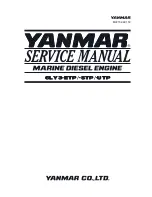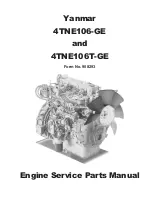
EN
English –
3
– The disconnection device must have an opening distance between con-
tacts which is sufficient to permit complete disconnection from the power
supply under the conditions required by overvoltage category III.
The disconnection device must be located in view of the automation and, if it is not
visible, must envision a system that blocks any accidental or unauthorised re-con-
nection of the power supply, in order to prevent any danger.
4.3 - Connection of accessories to motor
Accessories can be connected by cable
: use cables 1, 2, 3 (
fig. 5
) to connect
the accessories to the motor; refer to
fig. 5
of Chapter 6 - “Optional Accessories”
and pay attention to the following
warnings
:
– Cables 1, 2, 3 of the bus lines MUST NOT be connected to be electrical mains.
– To the White + White-black lead you can connect only one accessory at a time
from among the compatible ones.
– To the White- White-black lead you can connect only one accessory at a
time from among the compatible ones.
– The Open and Flows inputs are constrained to reach other, in other words they
must be used with the same pushbutton strip (
fig. 5
). As an alternative, if only the
White lead is available, you can use the step-by-step input.
–
Caution!
– The maximum length of the cables used to connect a wall-mounted
panel or a relay, is 100 m.
Accessories can be connected by a radio
(portable transmitters and certain cli-
matic sensor models): memorise these accessories in the motor during the program-
ming phases; refer to the procedures given in this manual and those given in the
manuals supplied with the devices.
PROGRAMMING AND ADJUSTMENTS
5
5.1 - Transmitter to the used for programming
procedures
•
The programming procedures can be performed exclusively with a Nice
transmitter having at least the following keys
s
,
n
,
t
.
• The programming procedures must be performed exclusively with a transmitter
memorised in “Mode I” (paragraph 5.7 or 5.9.1).
• If the transmitter used for programming controls multiple automation units, you
must select the “unit” corresponding to the automation you are programming be-
fore sending a command during a procedure.
5.2 - Positions in which the shutter/awning stops
automatically
The electronic system that controls the shutter/awning at all times can automatically
stop its movement when it reaches the stop positions programmed by the installer.
The programmable positions are (
fig. 4
):
– position “
0
” = upper limit switch: rolling shutter (or awning) completely rolled up;
– position “
1
” = lower limit switch: rolling shutter (or awning) completely unrolled.
When the stop positions have not yet been programmed, the shutter/awning can be
operated only in “hold-to-run” mode, i.e. keeping the control key pressed for the de-
sired duration of the manoeuvre; the movement stops as soon as the user releases
the key. Once the stop positions have been programmed, one need only press the
control key to start the shutter/awning moving in the desired direction, and it will au-
tomatically stop as soon as it reaches the programmed position.
5.3 - General warnings
• The stop positions must be set after motor has been installed onto the shutter/awn
-
ing and connected to its power supply.
• In cases of installations with several motors and/or receivers, before starting to
program you must disconnect the electrical supply to the motors and receivers you
do not wish to program.
• Scrupulously respect the time limits indicated in the procedures: after releasing a
key, you have 60 seconds to press the next key indicated in the procedure; other-
wise, when the time is up, the motor will perform six movements to communicate
cancellation of the procedure in progress.
• During programming, the motor performs a certain number of brief movements, as
a “response” to the command sent to the installer. Count the movements, regard-
less of their direction.
• Every time the motor is powered
2 movements
are performed
to indicate that it is
in one (or more) of the following conditions:
– radio memory empty (no transmitter is programmed);
– one or more of the “arrow” buttons not lowered (or one or both of the limit switch-
es are not programmed);
– direction of rotation of the motor is not programmed (in this case the motor moves
only in “hold-to-run” mode, within the limits of the limit switches, if these are pro-
grammed);
– it is a “virgin” motor, i.e. with factory settings (or with the memory totally erased
through procedure 5.10).
5.4 - Overview of the transmitters
5.4.1 - Compatible transmitters
Consult the Nice product catalogue or go to www.niceforyou.com to find the Nice
devices compatible with the radio receiver built into the motor.
5.4.2 - Transmitter memorisation hierarchy
In general a transmitter can be memorised as a FIRST transmitter or a SECOND
transmitter (or third, fourth, etc.).
A - First transmitter
A transmitter can be memorised as a first transmitter only if in the motor no oth-
er transmitter is memorised. For this memorisation, follow procedure 5.7 (this
memorises the transmitter in “Mode I”.
B - Second (or third, fourth, etc.) transmitting device
A portable transmitter (or a radio climate sensor) can be memorised as a second
(or third, fourth, etc.) transmitting device only if the First Transmitter is already
memorised in the motor. For this memorisation, follow one of the procedures giv-
en in section 5.9.
5.4.3 - Two procedures to memorise the keys of a transmitter
To memorise the keys of a transmitter, two different procedures can be used: “Mode
I” and “Mode II”.
• “
MODE I
” – This mode automatically transfers, the various commands available in
the motor, all together, into the various keys available on the transmitter, without
allowing the installer to change the combinations of commands and keys. Upon
completion of the procedure, each key will be combined with a command accord-
ing to the following diagram.
- key
s
(or key
1
): will be combined with
Raise
- key
n
(or key
2
): will be combined with the command
Stop
- key
t
(or key
3
): will be combined with the command
Lower
(if there is a fourth key on the transmitter .....)
- key
4
: will be combined with the command
Stop
Note
– If the keys of your transmitter have no symbols or numbers, see
fig. 3
to
identify them.
• “
MODE II
” – This mode allows you to manually combine one of the commands
available in the motor with one of the transmitter keys, giving the installer the option
of choosing the command and key combinations to use. At the end of the proce-
dure, to memorise another key with another command desired, it will be necessary
to repeat the procedure once again.
Warning!
– Each automation has its own list of commands that can be memorised
in Mode II; in the case of the present motor the list of commands available is given
in procedure 5.9.2.
5.4.4 - Number of transmitters that can be memorised
You can memorise 30 transmitters (including any radio climate sensors) if these are
all memorised in “Mode I”, or you can memorise 30 single commands (keys) if they
are all memorised in “Mode II”. The two modes can coexist up to a maximum limit
of 30 memorised units.
PROCEDURES
Summary of Contents for Era Plus L
Page 2: ......
Page 116: ...NL PL DE ES FR IT EN II a b a1 1 2 b1 6 2 4 3...
Page 117: ...EN IT FR ES DE PL NL III 1 2 g i h c M 10 mm e d f...
Page 125: ......
Page 126: ......
Page 127: ......
Page 128: ...IS0192A02MM_14 12 2015 www niceforyou com Nice SpA Oderzo TV Italia info niceforyou com...






































